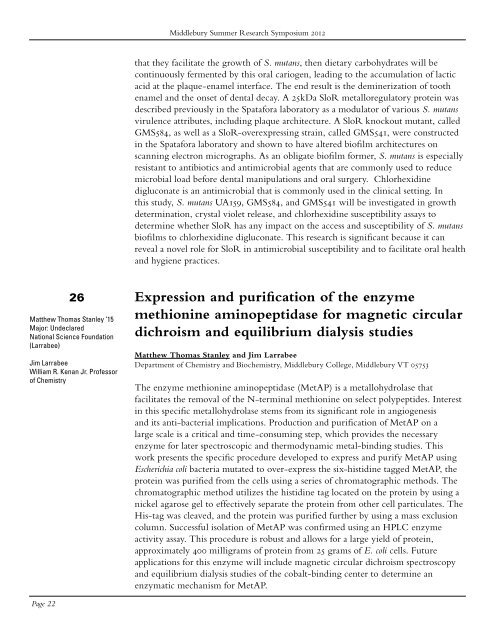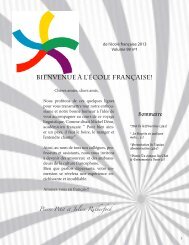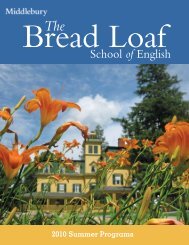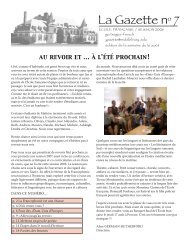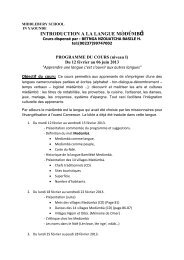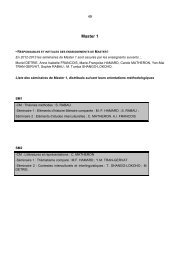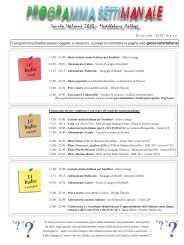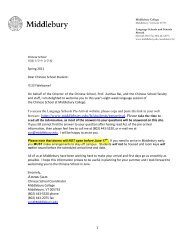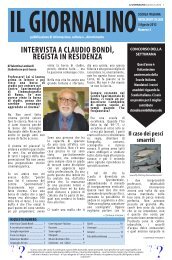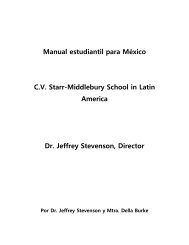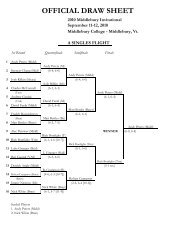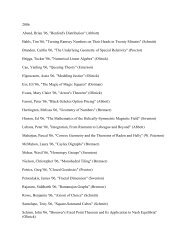2012 Summer Symposium Program - Middlebury College
2012 Summer Symposium Program - Middlebury College
2012 Summer Symposium Program - Middlebury College
You also want an ePaper? Increase the reach of your titles
YUMPU automatically turns print PDFs into web optimized ePapers that Google loves.
Page 22<br />
26<br />
Matthew Thomas Stanley ‘15<br />
Major: Undeclared<br />
National Science Foundation<br />
(Larrabee)<br />
Jim Larrabee<br />
William R. Kenan Jr. Professor<br />
of Chemistry<br />
<strong>Middlebury</strong> <strong>Summer</strong> Research <strong>Symposium</strong> <strong>2012</strong><br />
that they facilitate the growth of S. mutans, then dietary carbohydrates will be<br />
continuously fermented by this oral cariogen, leading to the accumulation of lactic<br />
acid at the plaque-enamel interface. The end result is the deminerization of tooth<br />
enamel and the onset of dental decay. A 25kDa SloR metalloregulatory protein was<br />
described previously in the Spatafora laboratory as a modulator of various S. mutans<br />
virulence attributes, including plaque architecture. A SloR knockout mutant, called<br />
GMS584, as well as a SloR-overexpressing strain, called GMS541, were constructed<br />
in the Spatafora laboratory and shown to have altered biofilm architectures on<br />
scanning electron micrographs. As an obligate biofilm former, S. mutans is especially<br />
resistant to antibiotics and antimicrobial agents that are commonly used to reduce<br />
microbial load before dental manipulations and oral surgery. Chlorhexidine<br />
digluconate is an antimicrobial that is commonly used in the clinical setting. In<br />
this study, S. mutans UA159, GMS584, and GMS541 will be investigated in growth<br />
determination, crystal violet release, and chlorhexidine susceptibility assays to<br />
determine whether SloR has any impact on the access and susceptibility of S. mutans<br />
biofilms to chlorhexidine digluconate. This research is significant because it can<br />
reveal a novel role for SloR in antimicrobial susceptibility and to facilitate oral health<br />
and hygiene practices.<br />
Expression and purification of the enzyme<br />
methionine aminopeptidase for magnetic circular<br />
dichroism and equilibrium dialysis studies<br />
Matthew Thomas Stanley and Jim Larrabee<br />
Department of Chemistry and Biochemistry, <strong>Middlebury</strong> <strong>College</strong>, <strong>Middlebury</strong> VT 05753<br />
The enzyme methionine aminopeptidase (MetAP) is a metallohydrolase that<br />
facilitates the removal of the N-terminal methionine on select polypeptides. Interest<br />
in this specific metallohydrolase stems from its significant role in angiogenesis<br />
and its anti-bacterial implications. Production and purification of MetAP on a<br />
large scale is a critical and time-consuming step, which provides the necessary<br />
enzyme for later spectroscopic and thermodynamic metal-binding studies. This<br />
work presents the specific procedure developed to express and purify MetAP using<br />
Escherichia coli bacteria mutated to over-express the six-histidine tagged MetAP, the<br />
protein was purified from the cells using a series of chromatographic methods. The<br />
chromatographic method utilizes the histidine tag located on the protein by using a<br />
nickel agarose gel to effectively separate the protein from other cell particulates. The<br />
His-tag was cleaved, and the protein was purified further by using a mass exclusion<br />
column. Successful isolation of MetAP was confirmed using an HPLC enzyme<br />
activity assay. This procedure is robust and allows for a large yield of protein,<br />
approximately 400 milligrams of protein from 25 grams of E. coli cells. Future<br />
applications for this enzyme will include magnetic circular dichroism spectroscopy<br />
and equilibrium dialysis studies of the cobalt-binding center to determine an<br />
enzymatic mechanism for MetAP.


